Global Business Environment: Auto-Mobile Industry Analysis Report
VerifiedAdded on 2021/02/21
|13
|3434
|133
Report
AI Summary
This report provides a comprehensive analysis of the global auto-mobile industry, focusing on the European market. It begins with an introduction to the global business environment and defines the factors influencing businesses. The report then applies a PESTLE analysis to the European auto-mobile industry, examining political, economic, social, technological, legal, and environmental factors, with a specific focus on the impact of electrification. Following this, the report applies Porter's Five Forces framework to the global auto-mobile industry, assessing the competitive landscape, including the threat of new entrants, substitute products, competitive rivalry, and the bargaining power of buyers and suppliers. The report provides a market share analysis of top auto-mobile companies and concludes by summarizing the key findings and implications of the analyses.

GLOBAL
BUSINESS
ENVIRONMENT
BUSINESS
ENVIRONMENT
Paraphrase This Document
Need a fresh take? Get an instant paraphrase of this document with our AI Paraphraser
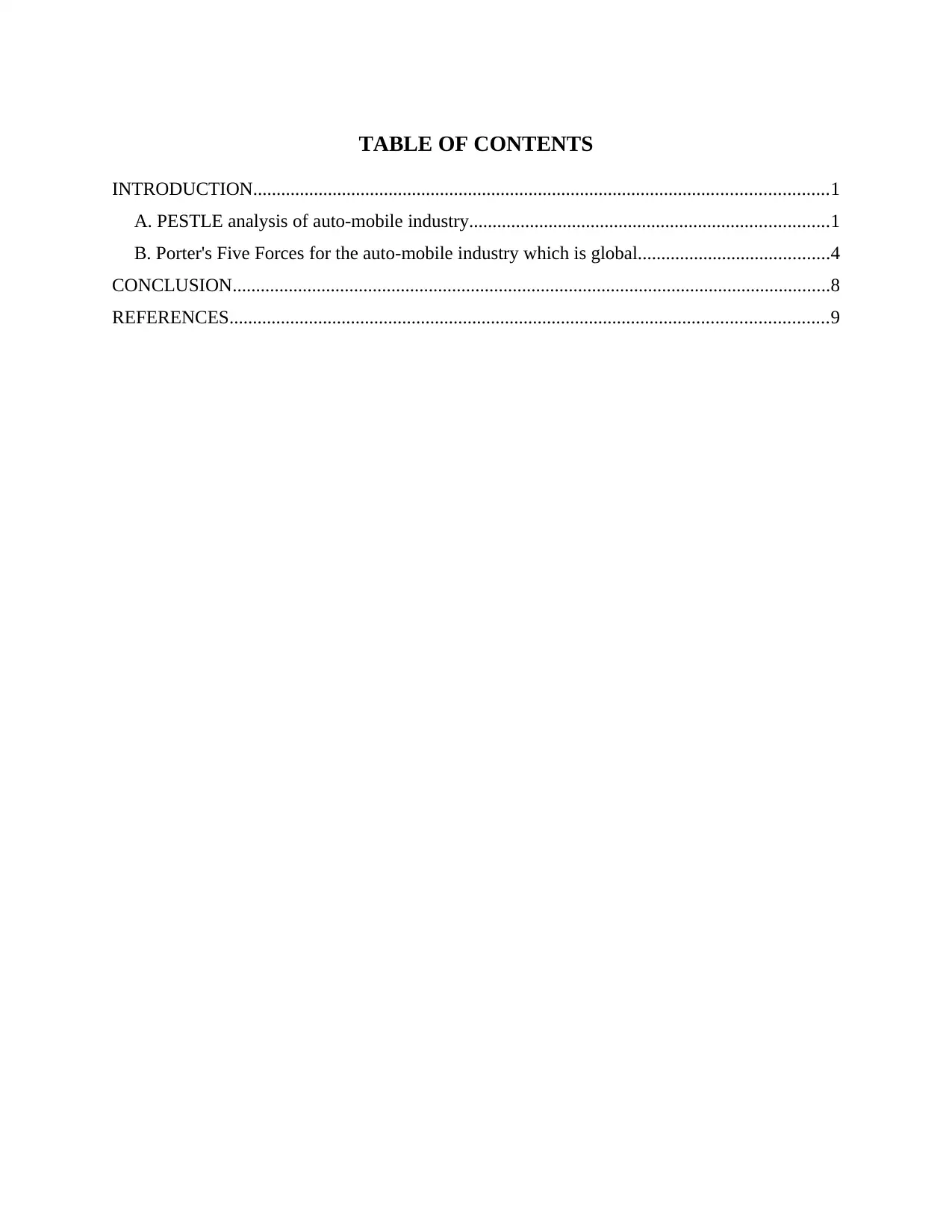
TABLE OF CONTENTS
INTRODUCTION...........................................................................................................................1
A. PESTLE analysis of auto-mobile industry.............................................................................1
B. Porter's Five Forces for the auto-mobile industry which is global.........................................4
CONCLUSION................................................................................................................................8
REFERENCES................................................................................................................................9
INTRODUCTION...........................................................................................................................1
A. PESTLE analysis of auto-mobile industry.............................................................................1
B. Porter's Five Forces for the auto-mobile industry which is global.........................................4
CONCLUSION................................................................................................................................8
REFERENCES................................................................................................................................9
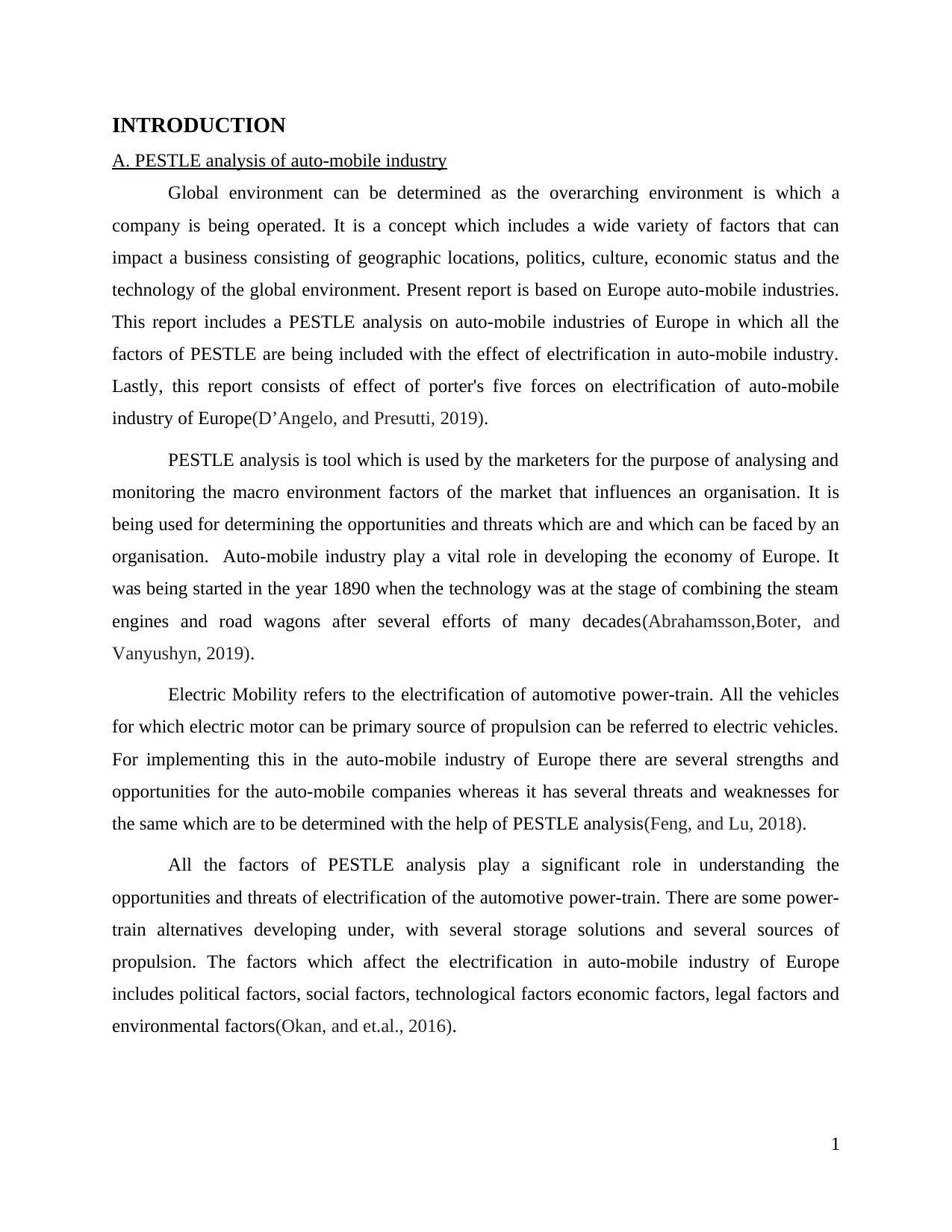
INTRODUCTION
A. PESTLE analysis of auto-mobile industry
Global environment can be determined as the overarching environment is which a
company is being operated. It is a concept which includes a wide variety of factors that can
impact a business consisting of geographic locations, politics, culture, economic status and the
technology of the global environment. Present report is based on Europe auto-mobile industries.
This report includes a PESTLE analysis on auto-mobile industries of Europe in which all the
factors of PESTLE are being included with the effect of electrification in auto-mobile industry.
Lastly, this report consists of effect of porter's five forces on electrification of auto-mobile
industry of Europe(D’Angelo, and Presutti, 2019).
PESTLE analysis is tool which is used by the marketers for the purpose of analysing and
monitoring the macro environment factors of the market that influences an organisation. It is
being used for determining the opportunities and threats which are and which can be faced by an
organisation. Auto-mobile industry play a vital role in developing the economy of Europe. It
was being started in the year 1890 when the technology was at the stage of combining the steam
engines and road wagons after several efforts of many decades(Abrahamsson,Boter, and
Vanyushyn, 2019).
Electric Mobility refers to the electrification of automotive power-train. All the vehicles
for which electric motor can be primary source of propulsion can be referred to electric vehicles.
For implementing this in the auto-mobile industry of Europe there are several strengths and
opportunities for the auto-mobile companies whereas it has several threats and weaknesses for
the same which are to be determined with the help of PESTLE analysis(Feng, and Lu, 2018).
All the factors of PESTLE analysis play a significant role in understanding the
opportunities and threats of electrification of the automotive power-train. There are some power-
train alternatives developing under, with several storage solutions and several sources of
propulsion. The factors which affect the electrification in auto-mobile industry of Europe
includes political factors, social factors, technological factors economic factors, legal factors and
environmental factors(Okan, and et.al., 2016).
1
A. PESTLE analysis of auto-mobile industry
Global environment can be determined as the overarching environment is which a
company is being operated. It is a concept which includes a wide variety of factors that can
impact a business consisting of geographic locations, politics, culture, economic status and the
technology of the global environment. Present report is based on Europe auto-mobile industries.
This report includes a PESTLE analysis on auto-mobile industries of Europe in which all the
factors of PESTLE are being included with the effect of electrification in auto-mobile industry.
Lastly, this report consists of effect of porter's five forces on electrification of auto-mobile
industry of Europe(D’Angelo, and Presutti, 2019).
PESTLE analysis is tool which is used by the marketers for the purpose of analysing and
monitoring the macro environment factors of the market that influences an organisation. It is
being used for determining the opportunities and threats which are and which can be faced by an
organisation. Auto-mobile industry play a vital role in developing the economy of Europe. It
was being started in the year 1890 when the technology was at the stage of combining the steam
engines and road wagons after several efforts of many decades(Abrahamsson,Boter, and
Vanyushyn, 2019).
Electric Mobility refers to the electrification of automotive power-train. All the vehicles
for which electric motor can be primary source of propulsion can be referred to electric vehicles.
For implementing this in the auto-mobile industry of Europe there are several strengths and
opportunities for the auto-mobile companies whereas it has several threats and weaknesses for
the same which are to be determined with the help of PESTLE analysis(Feng, and Lu, 2018).
All the factors of PESTLE analysis play a significant role in understanding the
opportunities and threats of electrification of the automotive power-train. There are some power-
train alternatives developing under, with several storage solutions and several sources of
propulsion. The factors which affect the electrification in auto-mobile industry of Europe
includes political factors, social factors, technological factors economic factors, legal factors and
environmental factors(Okan, and et.al., 2016).
1
⊘ This is a preview!⊘
Do you want full access?
Subscribe today to unlock all pages.

Trusted by 1+ million students worldwide
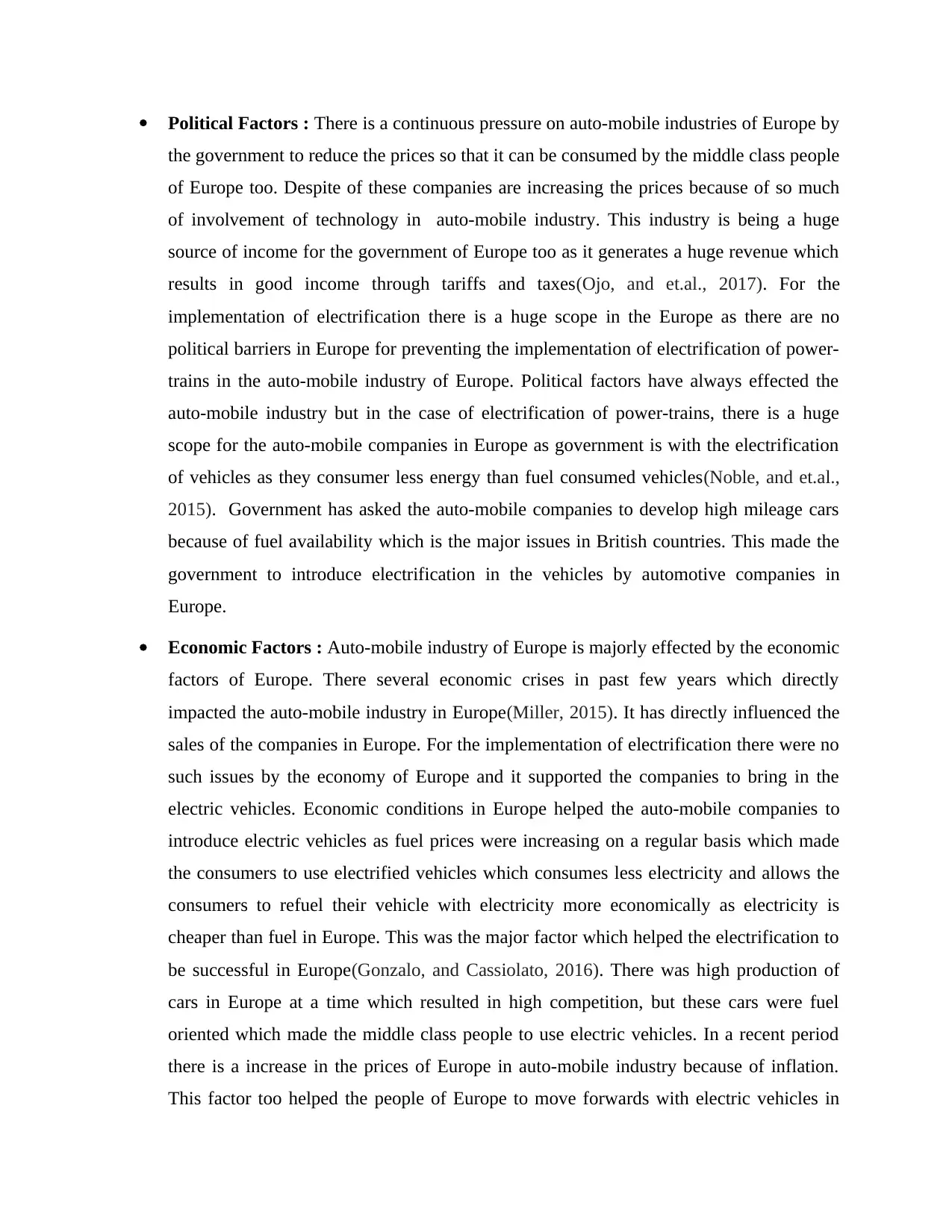
Political Factors : There is a continuous pressure on auto-mobile industries of Europe by
the government to reduce the prices so that it can be consumed by the middle class people
of Europe too. Despite of these companies are increasing the prices because of so much
of involvement of technology in auto-mobile industry. This industry is being a huge
source of income for the government of Europe too as it generates a huge revenue which
results in good income through tariffs and taxes(Ojo, and et.al., 2017). For the
implementation of electrification there is a huge scope in the Europe as there are no
political barriers in Europe for preventing the implementation of electrification of power-
trains in the auto-mobile industry of Europe. Political factors have always effected the
auto-mobile industry but in the case of electrification of power-trains, there is a huge
scope for the auto-mobile companies in Europe as government is with the electrification
of vehicles as they consumer less energy than fuel consumed vehicles(Noble, and et.al.,
2015). Government has asked the auto-mobile companies to develop high mileage cars
because of fuel availability which is the major issues in British countries. This made the
government to introduce electrification in the vehicles by automotive companies in
Europe.
Economic Factors : Auto-mobile industry of Europe is majorly effected by the economic
factors of Europe. There several economic crises in past few years which directly
impacted the auto-mobile industry in Europe(Miller, 2015). It has directly influenced the
sales of the companies in Europe. For the implementation of electrification there were no
such issues by the economy of Europe and it supported the companies to bring in the
electric vehicles. Economic conditions in Europe helped the auto-mobile companies to
introduce electric vehicles as fuel prices were increasing on a regular basis which made
the consumers to use electrified vehicles which consumes less electricity and allows the
consumers to refuel their vehicle with electricity more economically as electricity is
cheaper than fuel in Europe. This was the major factor which helped the electrification to
be successful in Europe(Gonzalo, and Cassiolato, 2016). There was high production of
cars in Europe at a time which resulted in high competition, but these cars were fuel
oriented which made the middle class people to use electric vehicles. In a recent period
there is a increase in the prices of Europe in auto-mobile industry because of inflation.
This factor too helped the people of Europe to move forwards with electric vehicles in
the government to reduce the prices so that it can be consumed by the middle class people
of Europe too. Despite of these companies are increasing the prices because of so much
of involvement of technology in auto-mobile industry. This industry is being a huge
source of income for the government of Europe too as it generates a huge revenue which
results in good income through tariffs and taxes(Ojo, and et.al., 2017). For the
implementation of electrification there is a huge scope in the Europe as there are no
political barriers in Europe for preventing the implementation of electrification of power-
trains in the auto-mobile industry of Europe. Political factors have always effected the
auto-mobile industry but in the case of electrification of power-trains, there is a huge
scope for the auto-mobile companies in Europe as government is with the electrification
of vehicles as they consumer less energy than fuel consumed vehicles(Noble, and et.al.,
2015). Government has asked the auto-mobile companies to develop high mileage cars
because of fuel availability which is the major issues in British countries. This made the
government to introduce electrification in the vehicles by automotive companies in
Europe.
Economic Factors : Auto-mobile industry of Europe is majorly effected by the economic
factors of Europe. There several economic crises in past few years which directly
impacted the auto-mobile industry in Europe(Miller, 2015). It has directly influenced the
sales of the companies in Europe. For the implementation of electrification there were no
such issues by the economy of Europe and it supported the companies to bring in the
electric vehicles. Economic conditions in Europe helped the auto-mobile companies to
introduce electric vehicles as fuel prices were increasing on a regular basis which made
the consumers to use electrified vehicles which consumes less electricity and allows the
consumers to refuel their vehicle with electricity more economically as electricity is
cheaper than fuel in Europe. This was the major factor which helped the electrification to
be successful in Europe(Gonzalo, and Cassiolato, 2016). There was high production of
cars in Europe at a time which resulted in high competition, but these cars were fuel
oriented which made the middle class people to use electric vehicles. In a recent period
there is a increase in the prices of Europe in auto-mobile industry because of inflation.
This factor too helped the people of Europe to move forwards with electric vehicles in
Paraphrase This Document
Need a fresh take? Get an instant paraphrase of this document with our AI Paraphraser

order to become economic and being cost effective method of travelling(D’Angelo, and
Presutti, 2019).
3
Presutti, 2019).
3
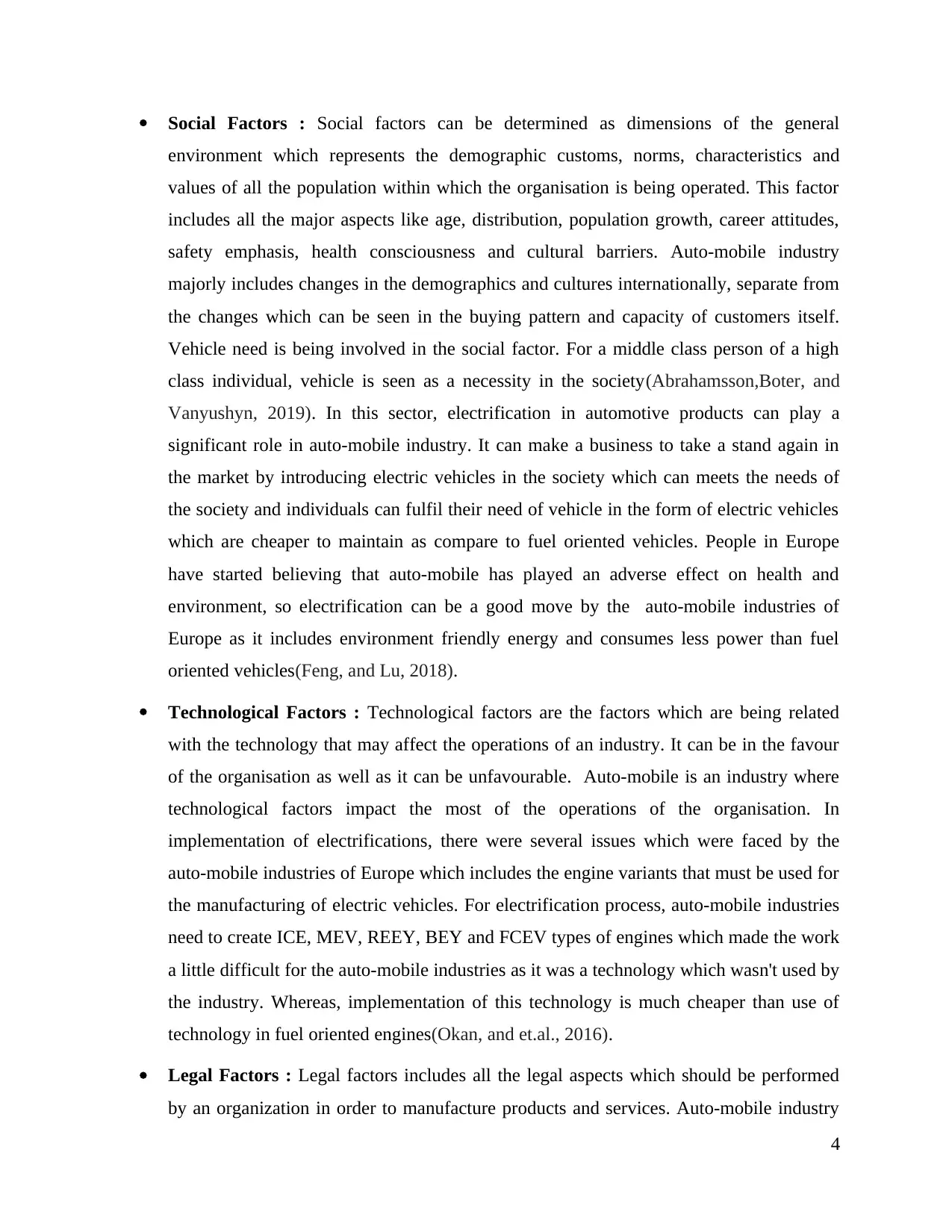
Social Factors : Social factors can be determined as dimensions of the general
environment which represents the demographic customs, norms, characteristics and
values of all the population within which the organisation is being operated. This factor
includes all the major aspects like age, distribution, population growth, career attitudes,
safety emphasis, health consciousness and cultural barriers. Auto-mobile industry
majorly includes changes in the demographics and cultures internationally, separate from
the changes which can be seen in the buying pattern and capacity of customers itself.
Vehicle need is being involved in the social factor. For a middle class person of a high
class individual, vehicle is seen as a necessity in the society(Abrahamsson,Boter, and
Vanyushyn, 2019). In this sector, electrification in automotive products can play a
significant role in auto-mobile industry. It can make a business to take a stand again in
the market by introducing electric vehicles in the society which can meets the needs of
the society and individuals can fulfil their need of vehicle in the form of electric vehicles
which are cheaper to maintain as compare to fuel oriented vehicles. People in Europe
have started believing that auto-mobile has played an adverse effect on health and
environment, so electrification can be a good move by the auto-mobile industries of
Europe as it includes environment friendly energy and consumes less power than fuel
oriented vehicles(Feng, and Lu, 2018).
Technological Factors : Technological factors are the factors which are being related
with the technology that may affect the operations of an industry. It can be in the favour
of the organisation as well as it can be unfavourable. Auto-mobile is an industry where
technological factors impact the most of the operations of the organisation. In
implementation of electrifications, there were several issues which were faced by the
auto-mobile industries of Europe which includes the engine variants that must be used for
the manufacturing of electric vehicles. For electrification process, auto-mobile industries
need to create ICE, MEV, REEY, BEY and FCEV types of engines which made the work
a little difficult for the auto-mobile industries as it was a technology which wasn't used by
the industry. Whereas, implementation of this technology is much cheaper than use of
technology in fuel oriented engines(Okan, and et.al., 2016).
Legal Factors : Legal factors includes all the legal aspects which should be performed
by an organization in order to manufacture products and services. Auto-mobile industry
4
environment which represents the demographic customs, norms, characteristics and
values of all the population within which the organisation is being operated. This factor
includes all the major aspects like age, distribution, population growth, career attitudes,
safety emphasis, health consciousness and cultural barriers. Auto-mobile industry
majorly includes changes in the demographics and cultures internationally, separate from
the changes which can be seen in the buying pattern and capacity of customers itself.
Vehicle need is being involved in the social factor. For a middle class person of a high
class individual, vehicle is seen as a necessity in the society(Abrahamsson,Boter, and
Vanyushyn, 2019). In this sector, electrification in automotive products can play a
significant role in auto-mobile industry. It can make a business to take a stand again in
the market by introducing electric vehicles in the society which can meets the needs of
the society and individuals can fulfil their need of vehicle in the form of electric vehicles
which are cheaper to maintain as compare to fuel oriented vehicles. People in Europe
have started believing that auto-mobile has played an adverse effect on health and
environment, so electrification can be a good move by the auto-mobile industries of
Europe as it includes environment friendly energy and consumes less power than fuel
oriented vehicles(Feng, and Lu, 2018).
Technological Factors : Technological factors are the factors which are being related
with the technology that may affect the operations of an industry. It can be in the favour
of the organisation as well as it can be unfavourable. Auto-mobile is an industry where
technological factors impact the most of the operations of the organisation. In
implementation of electrifications, there were several issues which were faced by the
auto-mobile industries of Europe which includes the engine variants that must be used for
the manufacturing of electric vehicles. For electrification process, auto-mobile industries
need to create ICE, MEV, REEY, BEY and FCEV types of engines which made the work
a little difficult for the auto-mobile industries as it was a technology which wasn't used by
the industry. Whereas, implementation of this technology is much cheaper than use of
technology in fuel oriented engines(Okan, and et.al., 2016).
Legal Factors : Legal factors includes all the legal aspects which should be performed
by an organization in order to manufacture products and services. Auto-mobile industry
4
⊘ This is a preview!⊘
Do you want full access?
Subscribe today to unlock all pages.

Trusted by 1+ million students worldwide
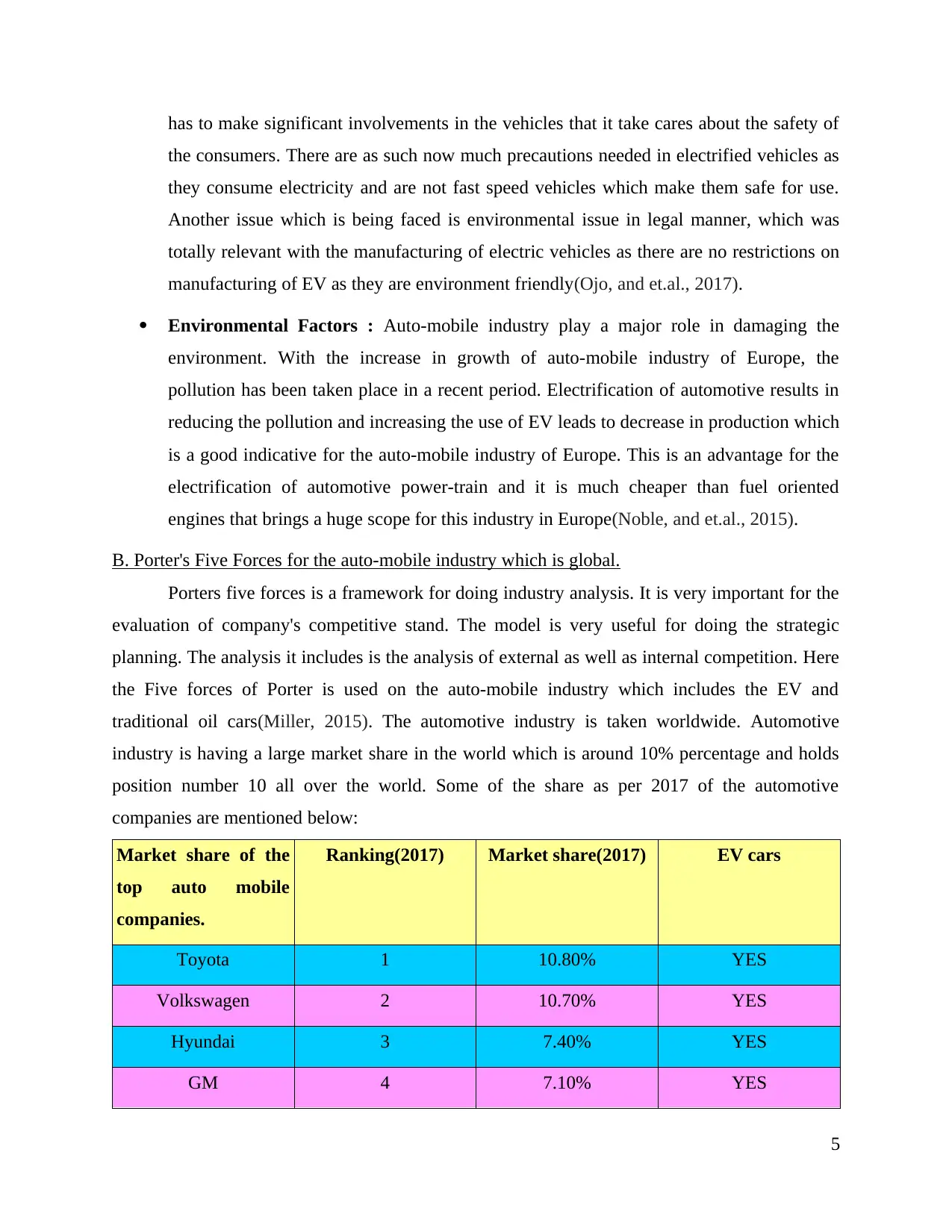
has to make significant involvements in the vehicles that it take cares about the safety of
the consumers. There are as such now much precautions needed in electrified vehicles as
they consume electricity and are not fast speed vehicles which make them safe for use.
Another issue which is being faced is environmental issue in legal manner, which was
totally relevant with the manufacturing of electric vehicles as there are no restrictions on
manufacturing of EV as they are environment friendly(Ojo, and et.al., 2017).
Environmental Factors : Auto-mobile industry play a major role in damaging the
environment. With the increase in growth of auto-mobile industry of Europe, the
pollution has been taken place in a recent period. Electrification of automotive results in
reducing the pollution and increasing the use of EV leads to decrease in production which
is a good indicative for the auto-mobile industry of Europe. This is an advantage for the
electrification of automotive power-train and it is much cheaper than fuel oriented
engines that brings a huge scope for this industry in Europe(Noble, and et.al., 2015).
B. Porter's Five Forces for the auto-mobile industry which is global.
Porters five forces is a framework for doing industry analysis. It is very important for the
evaluation of company's competitive stand. The model is very useful for doing the strategic
planning. The analysis it includes is the analysis of external as well as internal competition. Here
the Five forces of Porter is used on the auto-mobile industry which includes the EV and
traditional oil cars(Miller, 2015). The automotive industry is taken worldwide. Automotive
industry is having a large market share in the world which is around 10% percentage and holds
position number 10 all over the world. Some of the share as per 2017 of the automotive
companies are mentioned below:
Market share of the
top auto mobile
companies.
Ranking(2017) Market share(2017) EV cars
Toyota 1 10.80% YES
Volkswagen 2 10.70% YES
Hyundai 3 7.40% YES
GM 4 7.10% YES
5
the consumers. There are as such now much precautions needed in electrified vehicles as
they consume electricity and are not fast speed vehicles which make them safe for use.
Another issue which is being faced is environmental issue in legal manner, which was
totally relevant with the manufacturing of electric vehicles as there are no restrictions on
manufacturing of EV as they are environment friendly(Ojo, and et.al., 2017).
Environmental Factors : Auto-mobile industry play a major role in damaging the
environment. With the increase in growth of auto-mobile industry of Europe, the
pollution has been taken place in a recent period. Electrification of automotive results in
reducing the pollution and increasing the use of EV leads to decrease in production which
is a good indicative for the auto-mobile industry of Europe. This is an advantage for the
electrification of automotive power-train and it is much cheaper than fuel oriented
engines that brings a huge scope for this industry in Europe(Noble, and et.al., 2015).
B. Porter's Five Forces for the auto-mobile industry which is global.
Porters five forces is a framework for doing industry analysis. It is very important for the
evaluation of company's competitive stand. The model is very useful for doing the strategic
planning. The analysis it includes is the analysis of external as well as internal competition. Here
the Five forces of Porter is used on the auto-mobile industry which includes the EV and
traditional oil cars(Miller, 2015). The automotive industry is taken worldwide. Automotive
industry is having a large market share in the world which is around 10% percentage and holds
position number 10 all over the world. Some of the share as per 2017 of the automotive
companies are mentioned below:
Market share of the
top auto mobile
companies.
Ranking(2017) Market share(2017) EV cars
Toyota 1 10.80% YES
Volkswagen 2 10.70% YES
Hyundai 3 7.40% YES
GM 4 7.10% YES
5
Paraphrase This Document
Need a fresh take? Get an instant paraphrase of this document with our AI Paraphraser
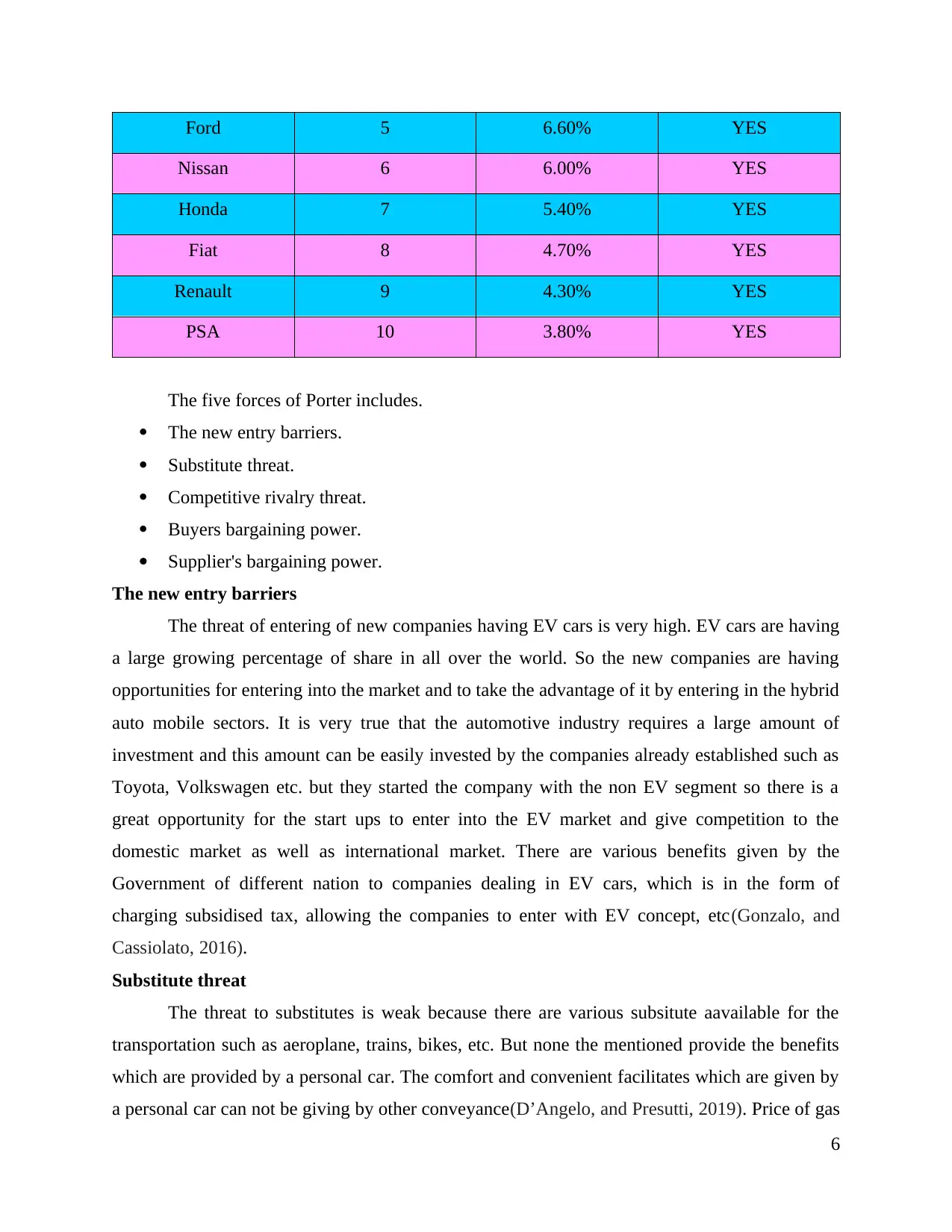
Ford 5 6.60% YES
Nissan 6 6.00% YES
Honda 7 5.40% YES
Fiat 8 4.70% YES
Renault 9 4.30% YES
PSA 10 3.80% YES
The five forces of Porter includes.
The new entry barriers.
Substitute threat.
Competitive rivalry threat.
Buyers bargaining power.
Supplier's bargaining power.
The new entry barriers
The threat of entering of new companies having EV cars is very high. EV cars are having
a large growing percentage of share in all over the world. So the new companies are having
opportunities for entering into the market and to take the advantage of it by entering in the hybrid
auto mobile sectors. It is very true that the automotive industry requires a large amount of
investment and this amount can be easily invested by the companies already established such as
Toyota, Volkswagen etc. but they started the company with the non EV segment so there is a
great opportunity for the start ups to enter into the EV market and give competition to the
domestic market as well as international market. There are various benefits given by the
Government of different nation to companies dealing in EV cars, which is in the form of
charging subsidised tax, allowing the companies to enter with EV concept, etc(Gonzalo, and
Cassiolato, 2016).
Substitute threat
The threat to substitutes is weak because there are various subsitute aavailable for the
transportation such as aeroplane, trains, bikes, etc. But none the mentioned provide the benefits
which are provided by a personal car. The comfort and convenient facilitates which are given by
a personal car can not be giving by other conveyance(D’Angelo, and Presutti, 2019). Price of gas
6
Nissan 6 6.00% YES
Honda 7 5.40% YES
Fiat 8 4.70% YES
Renault 9 4.30% YES
PSA 10 3.80% YES
The five forces of Porter includes.
The new entry barriers.
Substitute threat.
Competitive rivalry threat.
Buyers bargaining power.
Supplier's bargaining power.
The new entry barriers
The threat of entering of new companies having EV cars is very high. EV cars are having
a large growing percentage of share in all over the world. So the new companies are having
opportunities for entering into the market and to take the advantage of it by entering in the hybrid
auto mobile sectors. It is very true that the automotive industry requires a large amount of
investment and this amount can be easily invested by the companies already established such as
Toyota, Volkswagen etc. but they started the company with the non EV segment so there is a
great opportunity for the start ups to enter into the EV market and give competition to the
domestic market as well as international market. There are various benefits given by the
Government of different nation to companies dealing in EV cars, which is in the form of
charging subsidised tax, allowing the companies to enter with EV concept, etc(Gonzalo, and
Cassiolato, 2016).
Substitute threat
The threat to substitutes is weak because there are various subsitute aavailable for the
transportation such as aeroplane, trains, bikes, etc. But none the mentioned provide the benefits
which are provided by a personal car. The comfort and convenient facilitates which are given by
a personal car can not be giving by other conveyance(D’Angelo, and Presutti, 2019). Price of gas
6
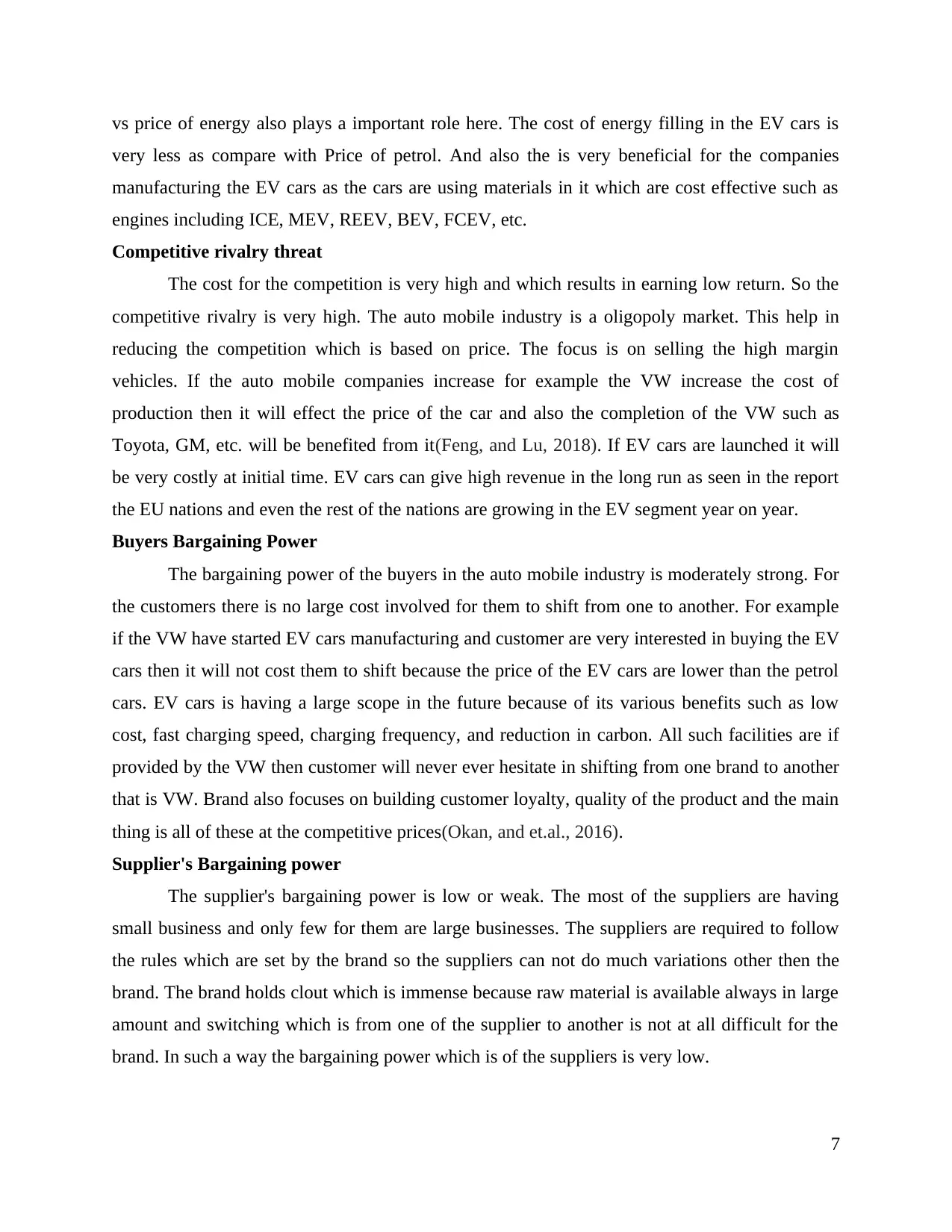
vs price of energy also plays a important role here. The cost of energy filling in the EV cars is
very less as compare with Price of petrol. And also the is very beneficial for the companies
manufacturing the EV cars as the cars are using materials in it which are cost effective such as
engines including ICE, MEV, REEV, BEV, FCEV, etc.
Competitive rivalry threat
The cost for the competition is very high and which results in earning low return. So the
competitive rivalry is very high. The auto mobile industry is a oligopoly market. This help in
reducing the competition which is based on price. The focus is on selling the high margin
vehicles. If the auto mobile companies increase for example the VW increase the cost of
production then it will effect the price of the car and also the completion of the VW such as
Toyota, GM, etc. will be benefited from it(Feng, and Lu, 2018). If EV cars are launched it will
be very costly at initial time. EV cars can give high revenue in the long run as seen in the report
the EU nations and even the rest of the nations are growing in the EV segment year on year.
Buyers Bargaining Power
The bargaining power of the buyers in the auto mobile industry is moderately strong. For
the customers there is no large cost involved for them to shift from one to another. For example
if the VW have started EV cars manufacturing and customer are very interested in buying the EV
cars then it will not cost them to shift because the price of the EV cars are lower than the petrol
cars. EV cars is having a large scope in the future because of its various benefits such as low
cost, fast charging speed, charging frequency, and reduction in carbon. All such facilities are if
provided by the VW then customer will never ever hesitate in shifting from one brand to another
that is VW. Brand also focuses on building customer loyalty, quality of the product and the main
thing is all of these at the competitive prices(Okan, and et.al., 2016).
Supplier's Bargaining power
The supplier's bargaining power is low or weak. The most of the suppliers are having
small business and only few for them are large businesses. The suppliers are required to follow
the rules which are set by the brand so the suppliers can not do much variations other then the
brand. The brand holds clout which is immense because raw material is available always in large
amount and switching which is from one of the supplier to another is not at all difficult for the
brand. In such a way the bargaining power which is of the suppliers is very low.
7
very less as compare with Price of petrol. And also the is very beneficial for the companies
manufacturing the EV cars as the cars are using materials in it which are cost effective such as
engines including ICE, MEV, REEV, BEV, FCEV, etc.
Competitive rivalry threat
The cost for the competition is very high and which results in earning low return. So the
competitive rivalry is very high. The auto mobile industry is a oligopoly market. This help in
reducing the competition which is based on price. The focus is on selling the high margin
vehicles. If the auto mobile companies increase for example the VW increase the cost of
production then it will effect the price of the car and also the completion of the VW such as
Toyota, GM, etc. will be benefited from it(Feng, and Lu, 2018). If EV cars are launched it will
be very costly at initial time. EV cars can give high revenue in the long run as seen in the report
the EU nations and even the rest of the nations are growing in the EV segment year on year.
Buyers Bargaining Power
The bargaining power of the buyers in the auto mobile industry is moderately strong. For
the customers there is no large cost involved for them to shift from one to another. For example
if the VW have started EV cars manufacturing and customer are very interested in buying the EV
cars then it will not cost them to shift because the price of the EV cars are lower than the petrol
cars. EV cars is having a large scope in the future because of its various benefits such as low
cost, fast charging speed, charging frequency, and reduction in carbon. All such facilities are if
provided by the VW then customer will never ever hesitate in shifting from one brand to another
that is VW. Brand also focuses on building customer loyalty, quality of the product and the main
thing is all of these at the competitive prices(Okan, and et.al., 2016).
Supplier's Bargaining power
The supplier's bargaining power is low or weak. The most of the suppliers are having
small business and only few for them are large businesses. The suppliers are required to follow
the rules which are set by the brand so the suppliers can not do much variations other then the
brand. The brand holds clout which is immense because raw material is available always in large
amount and switching which is from one of the supplier to another is not at all difficult for the
brand. In such a way the bargaining power which is of the suppliers is very low.
7
⊘ This is a preview!⊘
Do you want full access?
Subscribe today to unlock all pages.

Trusted by 1+ million students worldwide
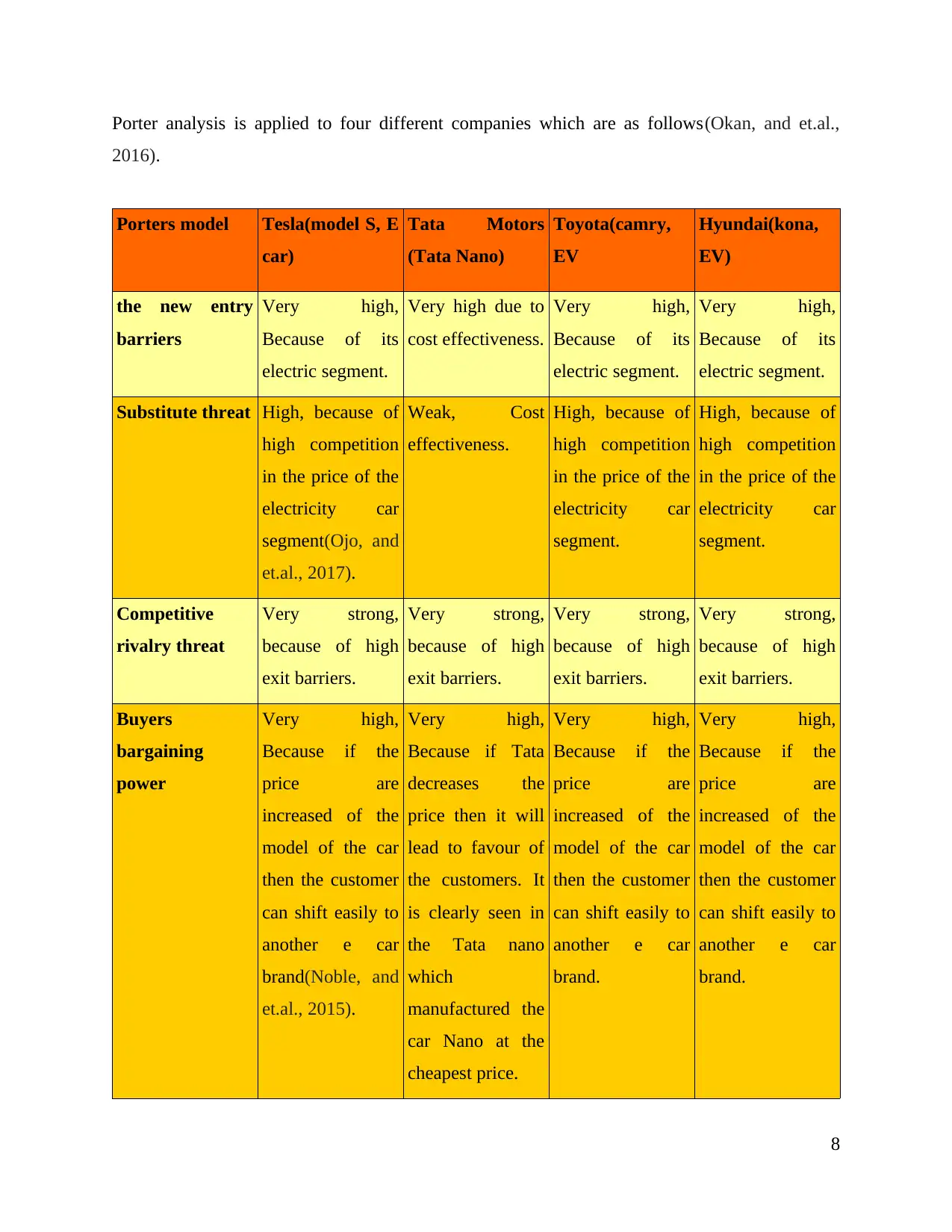
Porter analysis is applied to four different companies which are as follows(Okan, and et.al.,
2016).
Porters model Tesla(model S, E
car)
Tata Motors
(Tata Nano)
Toyota(camry,
EV
Hyundai(kona,
EV)
the new entry
barriers
Very high,
Because of its
electric segment.
Very high due to
cost effectiveness.
Very high,
Because of its
electric segment.
Very high,
Because of its
electric segment.
Substitute threat High, because of
high competition
in the price of the
electricity car
segment(Ojo, and
et.al., 2017).
Weak, Cost
effectiveness.
High, because of
high competition
in the price of the
electricity car
segment.
High, because of
high competition
in the price of the
electricity car
segment.
Competitive
rivalry threat
Very strong,
because of high
exit barriers.
Very strong,
because of high
exit barriers.
Very strong,
because of high
exit barriers.
Very strong,
because of high
exit barriers.
Buyers
bargaining
power
Very high,
Because if the
price are
increased of the
model of the car
then the customer
can shift easily to
another e car
brand(Noble, and
et.al., 2015).
Very high,
Because if Tata
decreases the
price then it will
lead to favour of
the customers. It
is clearly seen in
the Tata nano
which
manufactured the
car Nano at the
cheapest price.
Very high,
Because if the
price are
increased of the
model of the car
then the customer
can shift easily to
another e car
brand.
Very high,
Because if the
price are
increased of the
model of the car
then the customer
can shift easily to
another e car
brand.
8
2016).
Porters model Tesla(model S, E
car)
Tata Motors
(Tata Nano)
Toyota(camry,
EV
Hyundai(kona,
EV)
the new entry
barriers
Very high,
Because of its
electric segment.
Very high due to
cost effectiveness.
Very high,
Because of its
electric segment.
Very high,
Because of its
electric segment.
Substitute threat High, because of
high competition
in the price of the
electricity car
segment(Ojo, and
et.al., 2017).
Weak, Cost
effectiveness.
High, because of
high competition
in the price of the
electricity car
segment.
High, because of
high competition
in the price of the
electricity car
segment.
Competitive
rivalry threat
Very strong,
because of high
exit barriers.
Very strong,
because of high
exit barriers.
Very strong,
because of high
exit barriers.
Very strong,
because of high
exit barriers.
Buyers
bargaining
power
Very high,
Because if the
price are
increased of the
model of the car
then the customer
can shift easily to
another e car
brand(Noble, and
et.al., 2015).
Very high,
Because if Tata
decreases the
price then it will
lead to favour of
the customers. It
is clearly seen in
the Tata nano
which
manufactured the
car Nano at the
cheapest price.
Very high,
Because if the
price are
increased of the
model of the car
then the customer
can shift easily to
another e car
brand.
Very high,
Because if the
price are
increased of the
model of the car
then the customer
can shift easily to
another e car
brand.
8
Paraphrase This Document
Need a fresh take? Get an instant paraphrase of this document with our AI Paraphraser
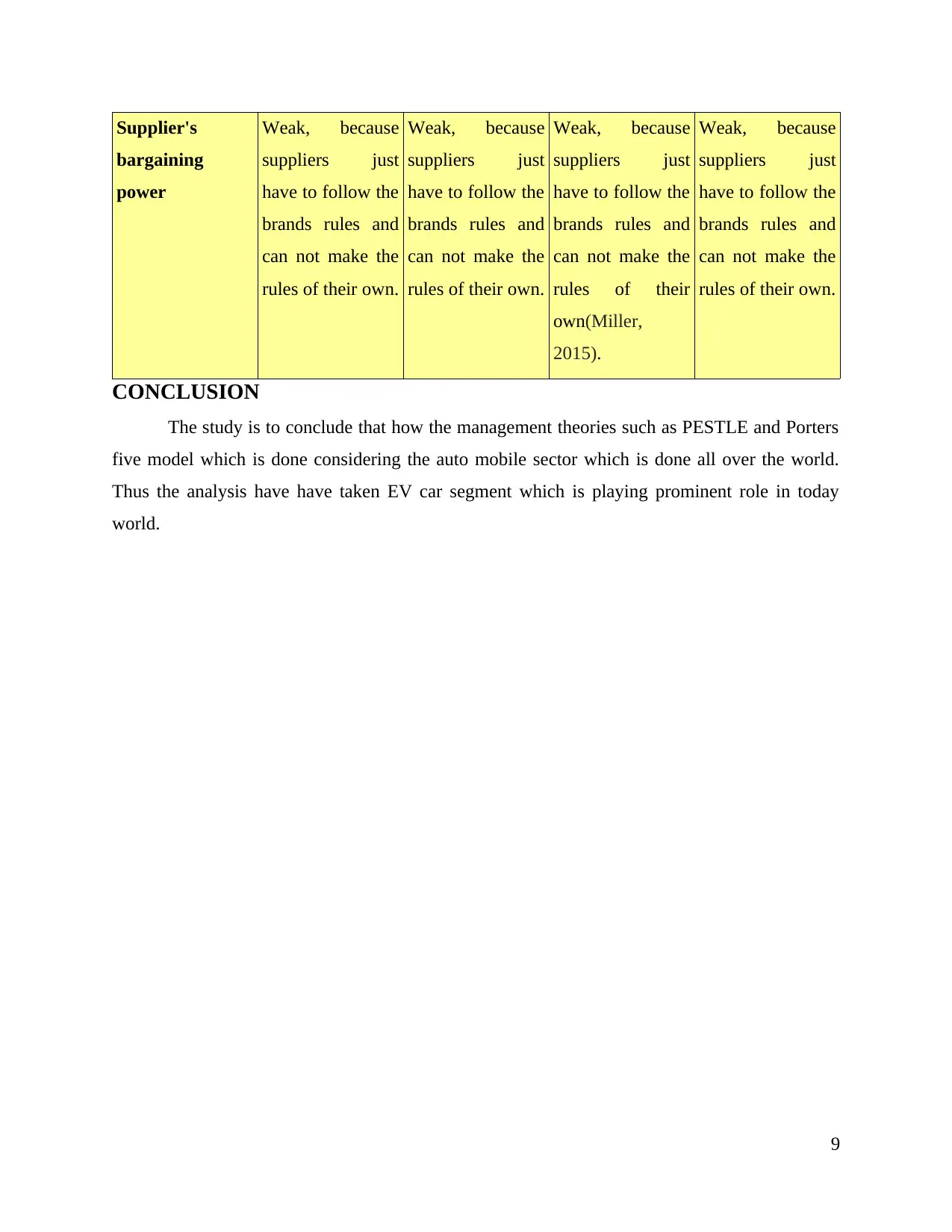
Supplier's
bargaining
power
Weak, because
suppliers just
have to follow the
brands rules and
can not make the
rules of their own.
Weak, because
suppliers just
have to follow the
brands rules and
can not make the
rules of their own.
Weak, because
suppliers just
have to follow the
brands rules and
can not make the
rules of their
own(Miller,
2015).
Weak, because
suppliers just
have to follow the
brands rules and
can not make the
rules of their own.
CONCLUSION
The study is to conclude that how the management theories such as PESTLE and Porters
five model which is done considering the auto mobile sector which is done all over the world.
Thus the analysis have have taken EV car segment which is playing prominent role in today
world.
9
bargaining
power
Weak, because
suppliers just
have to follow the
brands rules and
can not make the
rules of their own.
Weak, because
suppliers just
have to follow the
brands rules and
can not make the
rules of their own.
Weak, because
suppliers just
have to follow the
brands rules and
can not make the
rules of their
own(Miller,
2015).
Weak, because
suppliers just
have to follow the
brands rules and
can not make the
rules of their own.
CONCLUSION
The study is to conclude that how the management theories such as PESTLE and Porters
five model which is done considering the auto mobile sector which is done all over the world.
Thus the analysis have have taken EV car segment which is playing prominent role in today
world.
9
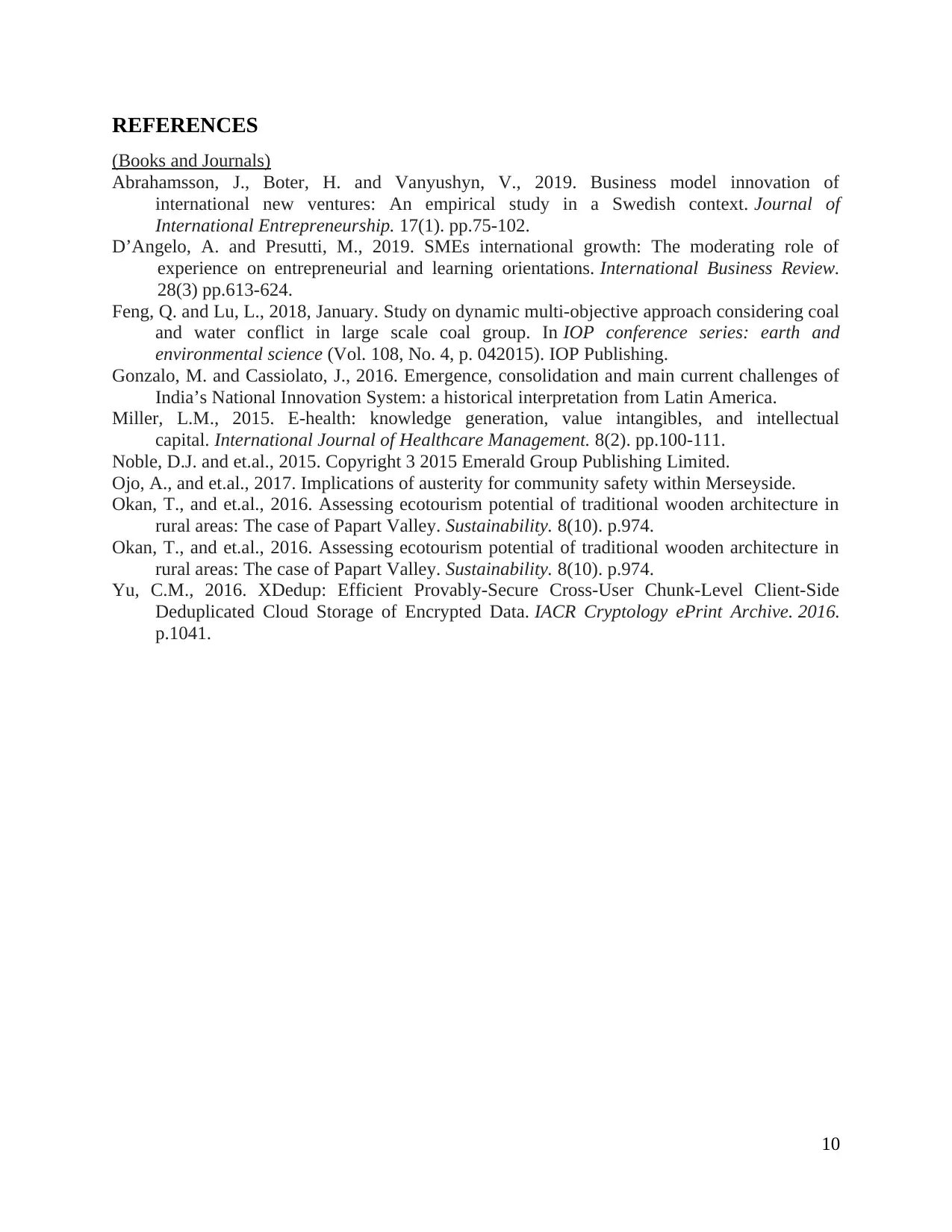
REFERENCES
(Books and Journals)
Abrahamsson, J., Boter, H. and Vanyushyn, V., 2019. Business model innovation of
international new ventures: An empirical study in a Swedish context. Journal of
International Entrepreneurship. 17(1). pp.75-102.
D’Angelo, A. and Presutti, M., 2019. SMEs international growth: The moderating role of
experience on entrepreneurial and learning orientations. International Business Review.
28(3) pp.613-624.
Feng, Q. and Lu, L., 2018, January. Study on dynamic multi-objective approach considering coal
and water conflict in large scale coal group. In IOP conference series: earth and
environmental science (Vol. 108, No. 4, p. 042015). IOP Publishing.
Gonzalo, M. and Cassiolato, J., 2016. Emergence, consolidation and main current challenges of
India’s National Innovation System: a historical interpretation from Latin America.
Miller, L.M., 2015. E-health: knowledge generation, value intangibles, and intellectual
capital. International Journal of Healthcare Management. 8(2). pp.100-111.
Noble, D.J. and et.al., 2015. Copyright 3 2015 Emerald Group Publishing Limited.
Ojo, A., and et.al., 2017. Implications of austerity for community safety within Merseyside.
Okan, T., and et.al., 2016. Assessing ecotourism potential of traditional wooden architecture in
rural areas: The case of Papart Valley. Sustainability. 8(10). p.974.
Okan, T., and et.al., 2016. Assessing ecotourism potential of traditional wooden architecture in
rural areas: The case of Papart Valley. Sustainability. 8(10). p.974.
Yu, C.M., 2016. XDedup: Efficient Provably-Secure Cross-User Chunk-Level Client-Side
Deduplicated Cloud Storage of Encrypted Data. IACR Cryptology ePrint Archive. 2016.
p.1041.
10
(Books and Journals)
Abrahamsson, J., Boter, H. and Vanyushyn, V., 2019. Business model innovation of
international new ventures: An empirical study in a Swedish context. Journal of
International Entrepreneurship. 17(1). pp.75-102.
D’Angelo, A. and Presutti, M., 2019. SMEs international growth: The moderating role of
experience on entrepreneurial and learning orientations. International Business Review.
28(3) pp.613-624.
Feng, Q. and Lu, L., 2018, January. Study on dynamic multi-objective approach considering coal
and water conflict in large scale coal group. In IOP conference series: earth and
environmental science (Vol. 108, No. 4, p. 042015). IOP Publishing.
Gonzalo, M. and Cassiolato, J., 2016. Emergence, consolidation and main current challenges of
India’s National Innovation System: a historical interpretation from Latin America.
Miller, L.M., 2015. E-health: knowledge generation, value intangibles, and intellectual
capital. International Journal of Healthcare Management. 8(2). pp.100-111.
Noble, D.J. and et.al., 2015. Copyright 3 2015 Emerald Group Publishing Limited.
Ojo, A., and et.al., 2017. Implications of austerity for community safety within Merseyside.
Okan, T., and et.al., 2016. Assessing ecotourism potential of traditional wooden architecture in
rural areas: The case of Papart Valley. Sustainability. 8(10). p.974.
Okan, T., and et.al., 2016. Assessing ecotourism potential of traditional wooden architecture in
rural areas: The case of Papart Valley. Sustainability. 8(10). p.974.
Yu, C.M., 2016. XDedup: Efficient Provably-Secure Cross-User Chunk-Level Client-Side
Deduplicated Cloud Storage of Encrypted Data. IACR Cryptology ePrint Archive. 2016.
p.1041.
10
⊘ This is a preview!⊘
Do you want full access?
Subscribe today to unlock all pages.

Trusted by 1+ million students worldwide
1 out of 13
Related Documents
Your All-in-One AI-Powered Toolkit for Academic Success.
+13062052269
info@desklib.com
Available 24*7 on WhatsApp / Email
![[object Object]](/_next/static/media/star-bottom.7253800d.svg)
Unlock your academic potential
Copyright © 2020–2025 A2Z Services. All Rights Reserved. Developed and managed by ZUCOL.





